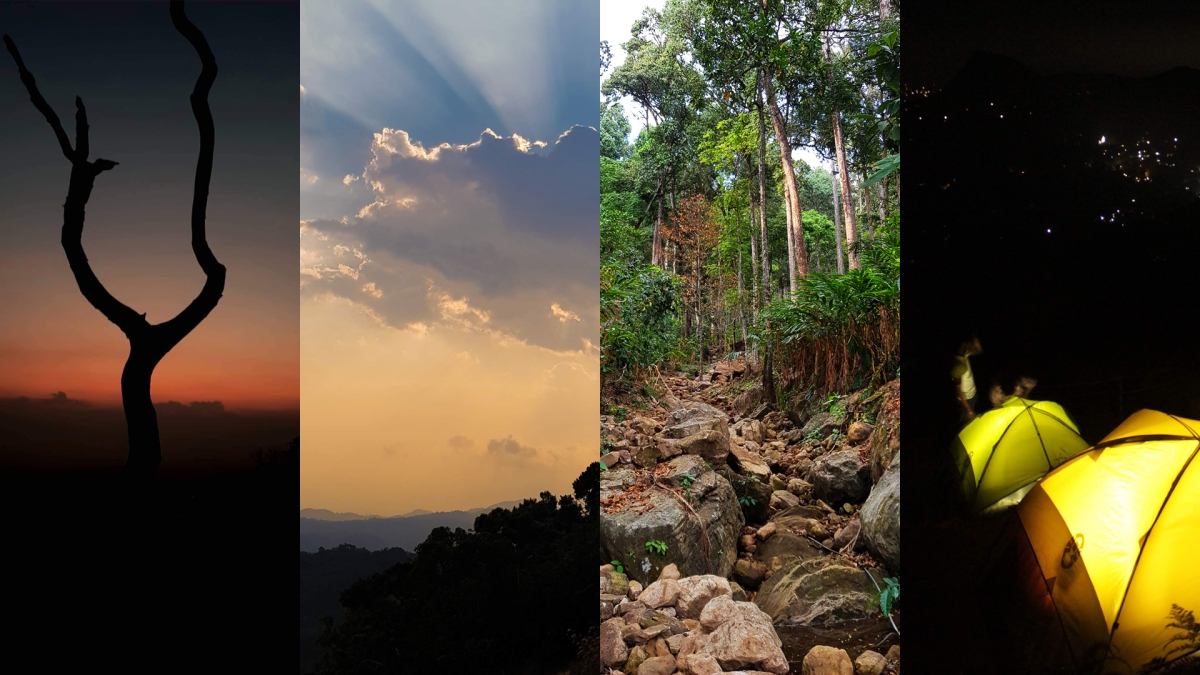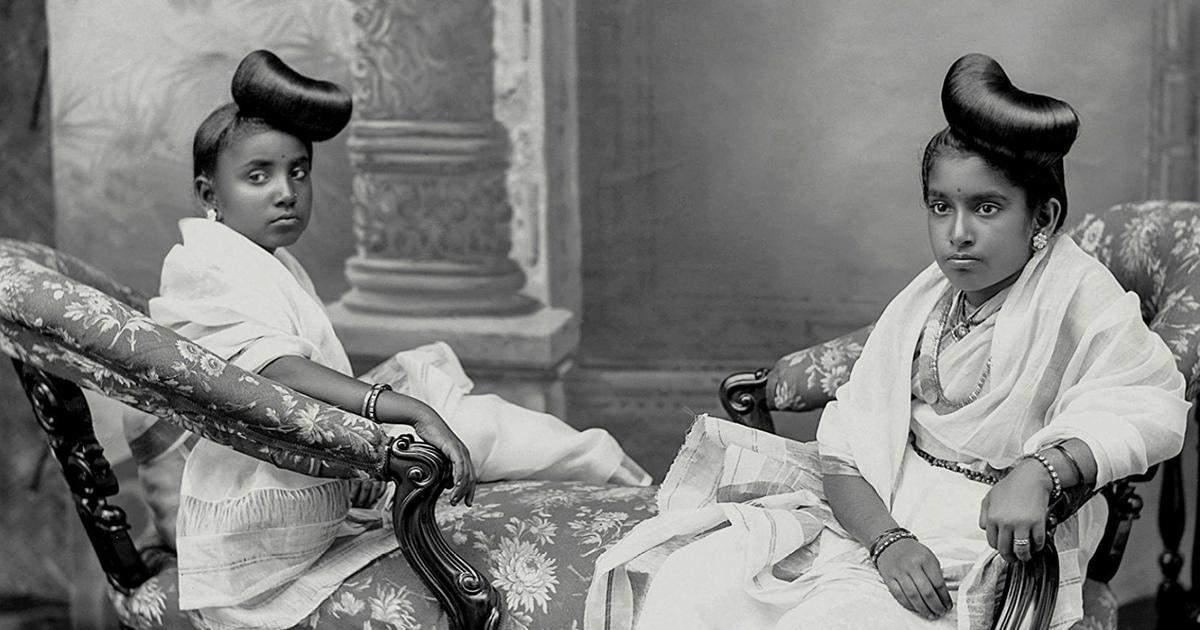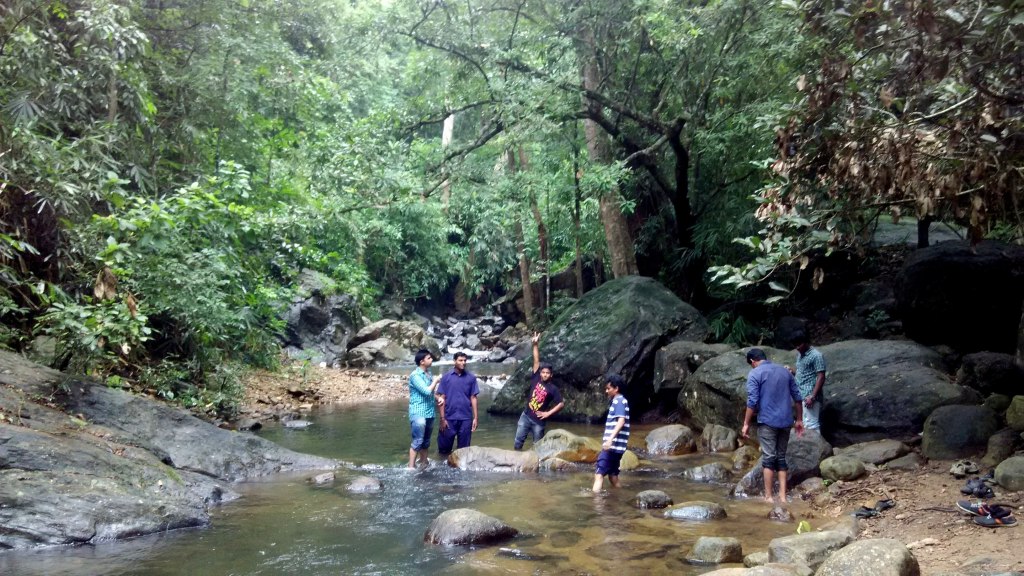It was a depressing day at the office. Staring at the computer every day for work was increasingly getting monotonous. I knew I needed a change of environment fast or I’m gonna run super low on my batteries. My friend and I for a very long time had been discussing about a campsite in Munnar after seeing their Instagram photos. They host the trekkers on top of a series of hills by the name of Letchmi Hills, which was part of the expansive Letchmi estate. We often talked about it, planned various timelines, the gear that we should carry and all that for a very long time. But in the end, it would end up being a no go for some reason or the other.
But today was different wasn’t it? I was looking for the spark to get out of that rut somehow. The place in Munnar crossed my mind, I knew I need to go there fast. It was a Friday that this plan came into my mind and planning for the weekend would be too small on the trip of a trip so, I decided to take Monday off too. I rang up my friend then and told him about the plan. It was a spontaneous one and from the tone of his voice, I realised that he needed a change of atmosphere too. He was in!
Then quickly rang up the trekking providers and booked the slot for Sunday. Days and months of planning and contemplating when to go for the trip were instantly done. I realised that the more we think about doing something, the chances are less of accomplishing it. You need to just take the first step and think about the rest later in certain scenarios.
Now, we had booked for Sunday and decided to make a stop at Kochi to visit the famous Kochi Muziris Biennale which is India’s Largest Art Festival and Biggest Contemporary Art Festival in Asia. I wanted to visit that event too but was buried deep in the books due to ‘extensive planning’. We decided to travel in his bike to save on travel costs and also to cover more regions in minimum time. It was a Royal Enfield Bullet 500, so that would provide more of a comfortable ride for both of us.
We planned to stay the night (Saturday) at Kochi and head towards Munnar the next day. Now, staying at a hotel would inflate our budget, so I started looking for a very sufferable cheap stay for us. My friend suggested a place called Peter’s Inn which was a dormitory. It was on the same building space as the MG Road metro station of the Kochi Metro. It seemed like a reasonable place and booked the place through Booking.com. (It costed us just Rs. 581 for two beds). We were just planing for a small layover so that we can continue riding towards Munnar the next day without exhaustion.
Check out Peter’s Inn here: Booking.com
The next day morning, we had packed our small bags with a few stuff and headed off to the Pazhavangadi Temple (which is done ritually before any long journey) and broke a coconut as offering to Ganesha. It was early 5:00 am and you could see people coming in to pray before going off to jobs as well as other riders. The cold mornings of Trivandrum, with the empty streets and the yellow sodium vapour lamps, gives it a charm unlike any other (Say no to white LEDs lol). These lights will slowly be replaced soon but I pray that they let them stay because someone loves the yellow!
Okay, all that I love about Trivandrum needs to be mentioned in another article. Now we are going to start our engine to head towards Kochi. The Bullet woke up to the familiar thump that reverberated and tore through the eerie of the darkness, and we set out towards the North.
The initial rider was my friend and I usually don’t like to pick up the big ass bike which weighs close to 200 kg with my kind of physique. We had travelled many times like this; you just can’t get the feeling of riding to places on your motorcycle, going wherever you want by the thought. It is an underrated pleasure and freedom that I have grown to appreciate (Now that it is the lockdown and all). Cruising through the tarmac while the sun is rising is something that I love always.
We usually skip breakfast on such long rides and would compensate with a heavy lunch. The main joint that we love is the Mullapandal Toddy Shop in Thripunitura, Kochi. (Mullapandal means Jasmine Roofed) And they have done justice to the name by having the jasmine climber all over the roof. It seems like a small shack on the outside but can hold close to 50 people in there. But the popularity of this place is unparalleled. You get all local toddy shop delicacies at affordable rates and with an okayish ambience. I am a big fan of their duck roast and rabbit curry and especially the rabbit curry (which after eating just overpowers everything else). So we got there by about 11:30 am which was a bit early because the main dishes were just getting ready.

We decided to take it slow and ordered some Tapioca, Appam, duck curry, and Clam meat fry (another fav which can be eaten just like chips) and of course Toddy to flush it all down. But the signature dishes like the rabbit curry weren’t getting ready anytime soon. And the next place in our itinerary was the Muziris Biennale which is far away from the place from where we were. With a heavy heart, we had to leave the place for the Biennale.
The Kochi Biennale is hosted at Fort Kochi and nearby places where all kinds of contemporary art and craftsmanships are displayed. It has loads of people coming in from all over the world on every edition due to its increasing popularity. Our first stop was the Fort Kochi beach which has an odd charm from all the beaches I’ve been to. But this one hits home always. The only negative would be the play of the high tide/low tides which dumps the trash from the bottom of the sea to all over the beach killing the vibe. Sort of nature’s way of spitting out what wasn’t healthy for it.
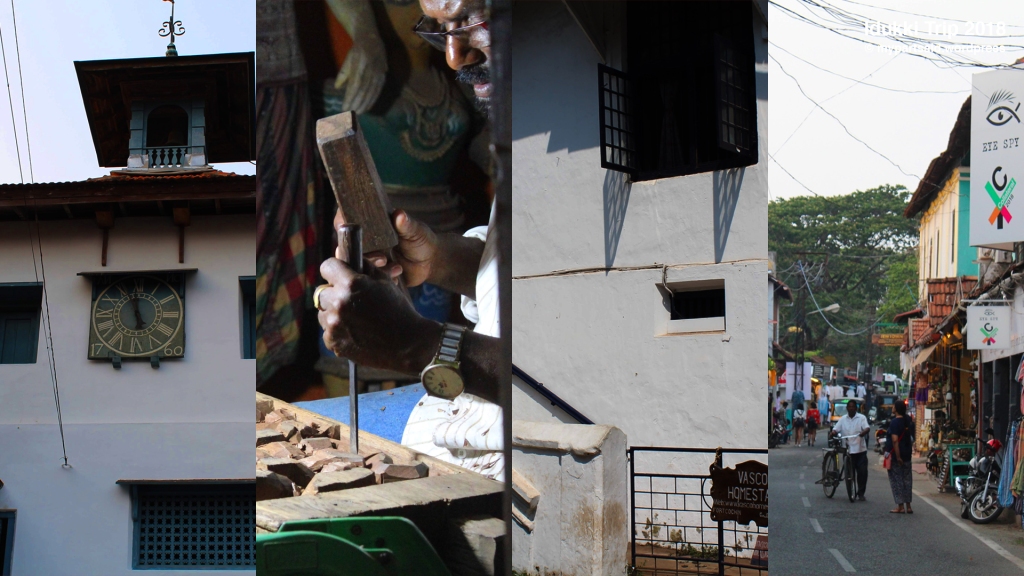
I had many memories associated with Fort Kochi and Kochi itself mostly because it was where my ex and I used to roam around unapologetically like every other couple. I can understand why the organisers chose this area as the venue as it is a place of a synergy of many cultures and architecture. Each street gives you the vibes of different nations and religions. One one side you have the Dutch architecture, on the other some British and even Jewish. That Anglo-Indian feel is in every nook and corner and feels like you’ve entered some antique shop. Everything is in stark contrast to one another yet shares something in common.
And mind you I’m not an art connoisseur, but I am mostly (helplessly) trying to understand art everywhere I go. Also secretly hoping to get into the whole art appreciation thing (like looking at a painting and deducting the meanings of the same just like that). And boy..I realised where I stood when I started to see the works displayed over there. Some even took over the entire rooms and some needed huge warehouses to be displayed. I was awestruck by all the colours and the materials used for the display and it was more than what I had expected. But having no clue of what most of them meant, my friend and I tried to comprehend some of it from the information displayed there. As I said, I don’t know how to explain the art, but here are some pictures that I clicked at the main venue which I found interesting. All credits go to their respective owners.

Another thing about the Biennale is that there are multiple venues scattered all over Fort Kochi and Mattancherry region. Which pushes the visitors to explore the area by foot and see the world out of the usual tourist traps. The shopkeepers are also happy with the sudden influx of people coming in due to the window shopping that occurs while moving from venue to venue. The streets of Fort Kochi are a sight to experience and embrace and I made sure to come here once in a while. Kudos to the organisers for conducting such a wonderful event by the Queen of the Arabian Sea.
Now my friend and I were dumbfounded by many items over there and came out blank of having not understood the meaning of most displays. We realised it was time to check in to the dormitory in MG Road. Upon reaching the place we had a hard time figuring out where the entrance was, as it was part of the Metro station. Finally, realised it was through a narrow alley by the side of the station. We checked in and was shocked to see the surprisingly good amenities like a personal locker and a wonderful bathroom. (All under Rs. 581 for two beds). And it was safe for female travellers too.
After that, we decided to explore the LuLu Mall and get something to eat for dinner. We initially planned to munch at some Thattukada, but upon reaching the food court of the mall and being hungry, the Subway stall caught my eye. And we decided to munch on two delicious subs for the day. The night was still young and going back to the dormitory would be a fun kill, so we decided to go back to the Fort Kochi beach. Riding through the empty streets of the Kochi with the cold creeping in from the sea breeze and the Enfield’s thud was mesmerising. We bought ice-creams from an almost shut shop and sat down on one of the pavements of the beachside. There were similar groups on all sides of the beach and few policemen were constantly patrolling and when they reached us, they flashed lights over to check whether we were trying to get high at the beach. But all they could find were two 20 plus-year-olds having ice-cream.
After staying till midnight we rushed back to the dorm and crashed there to recover from the long day of travelling all over Kochi.
By about 6:30 am we woke up and showered and packed everything back into the bike. The next leg of our journey was about to begin, towards Munnar town! We were on the road by 7:30 am and had to escape the traffic and like always skipped the breakfast. After close to two hours of riding, the sun was getting stronger but we were slowly going up in elevation. So even with the heat, the air was becoming cooler. And finally, we were surrounded by hills all around. The bike was going through the roads that hugged the hills and the settlements were getting scarce. The roads were also getting narrower with extremely vigilant drives making sure not to lose control but surprisingly the KSRTC (Kerala Road Transport Corporation) buses were in a hurry zooming in both directions like it is an Autobahn.
Finally, we saw the town, it was safely tucked in and surrounded by multiple hills all around it. It was a beautiful view from a distance. But upon reaching the place, it was jam-packed with people and tourists. To add to the commotion a group of Superbike riders came in with their beasts and started revving all over. Although I’m a lover of Superbikes, right then they were giving me a migraine. Munnar (Means Three Rivers) is referring to the place of the confluence of three rivers. Its actual joining place is higher up before the town and the joined river is flowing through the town. Around 70% of the shops were selling homemade chocolate or fresh tea leaves. Even the smell of chocolate and the tea leaves was in the air. The sun was strong, yet the air was cold, it was a strange atmosphere. We reached by around 11:45 am and were hungry and super tired.
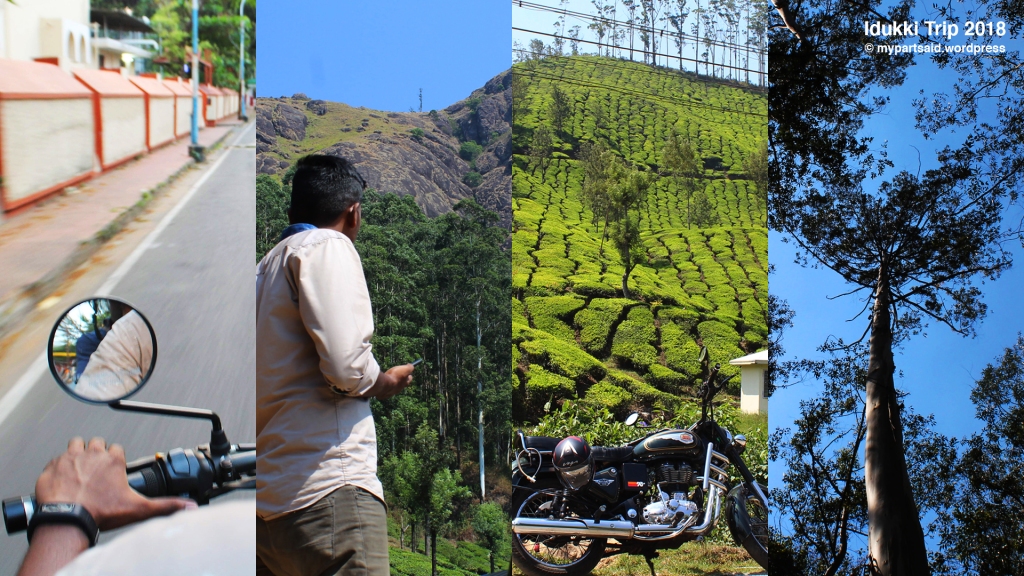
We decide to explore the part of the town and nearby areas to find a good hotel. We rode to the outskirts of the town and saw many tea plantations and slender trees. The roadside sellers were selling fresh carrots, beetroot and cut carrots dipped in salted syrup. This was the perfect place to crash after a good lunch, we thought. We relied on Google Maps to get the best rated ‘family’ (a.k.a affordable) restaurant in town. We found one and reached the place. The only thing on their menu (since we reached there early afternoon) was Biriyani. Now, mind you I’m not a huge biryani fan. But we ordered two plates and I ordered a Coco-cola along with it. I didn’t know what was wrong, but the flavour of the Biryani and the Coke wasn’t going well at all. Was it because of the Coke or the Biriyani, I couldn’t tell. But it wasn’t a pleasant experience.
After lunch, we went back to the plantation with the long slender trees. There were cement benches on the side of the plantation and we lay down on them for a short rest and was visibly tired from all the riding and exploring. It was a pleasant experience. The sky was stark blue, on one side we had the plantation and on the other side of the road, we had a green playground, where guys were playing football. And the whole place was surrounded by hills. Seeing that playground next to those hills reminded me of some pictures of Ladakh that I saw on Facebook. I love these moments of solitude with nature accompanying with the sound of the wind. I fell into a nap for a while. And my friend woke me up after like 20 minutes.
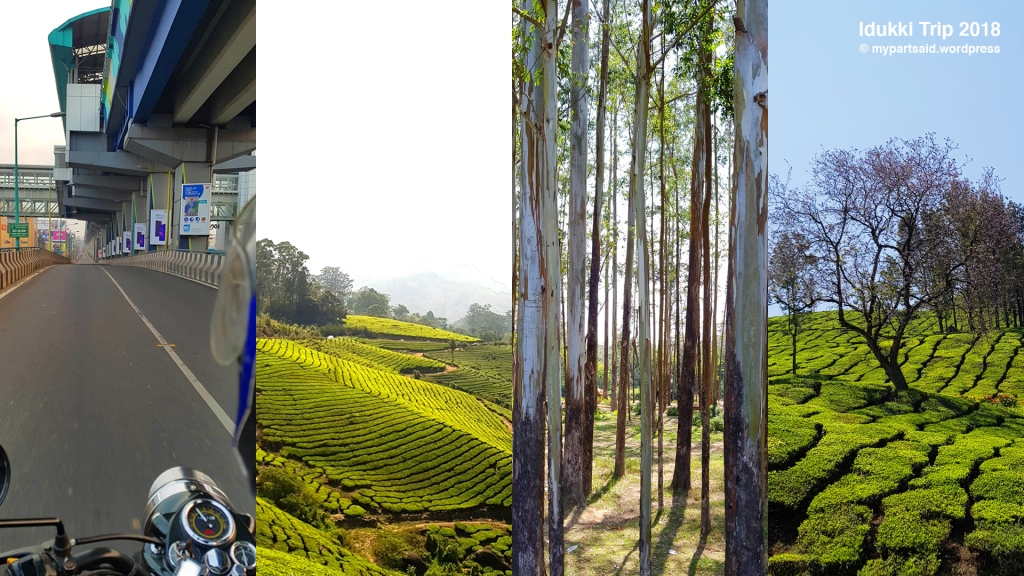
It was time to report to the trekking area. I checked the map and realised that the place was much before Munnar Town. We quickly drove back to the place and found no one over there. I called up the guy who we booked the trek with and he asked us to look for a small house next to where we were standing. I climbed up to the house and it was a thatched one and couldn’t find anybody.
I called the guy up again, he said asked to knock and wake up the guide who might be sleeping. I knocked multiple times but still, no one answered. Finally, I pushed open the door to see a guy lying wasted on the bed. And I had to go in and wake him up. He came to his senses and was surprised to see in me in his room. I told him about why I intruded as it was time to go up the hill and he needed to come to his senses. He got up and led us to another room where there was a carrom board and nothing else. Just like a play area. He said that there were more people to come over with us and we need to wait for them. And he went down the road to run some errands.
We sat inside the room and after some time a group of four people showed up, they seemed of our age and introduced themselves. They were a bunch of students from Aluva, Kochi and came by car. They were a fun lot, passing jokes amongst each other and it was too funny to keep a straight face in front of them. The carrom board caught their eye and got us into playing it as well. The game started to get heated up and well over 30 mins passed when the guide returned.
He called two autos for us and we got into towards the start site. We travelled for about 500 metres and got off. Three other people who were from Kozhikode were waiting for us there. They were much older than us. The guide came in the last auto and briefed us about the trek. That it would be of medium difficulty and will take an hour for him usually. We were ready for the trek and was pumped up!
We started going directly into a not so laid out entry into the forest side by the road. Streams were coming down, which the guide said was freshwater. The angle of ascent was getting steeper now, and surrounding us were mostly plantations of Cardamom giving a thick cover on either side. The guide told us that the seasonal trekkers who usually come to this spot get lost most of the time and even one guy got lost in the denser part of the forest uphill and needed considerable effort from the trek organisers to find him. You could tell he wasn’t kidding because the path was too complex and some of the steep elevations seemed impossible until the guide climbed over them.
After a few minutes of climbing, the so-called enthusiastic trekkers were gasping for breath. Well me too. Then we came across a few huts which were occupied by the guest labourers of the Cardamom plantation. We stood there for a while to catch our breath. They found our situation funny and some of them were laughing (Well I assumed that was for us). They directed us to drink the water from the stream coming down saying that it was safe to do so. There was a hose, which sourced water from this stream and everyone ran to get a few gulps of water. The guide’s expression was of the sorts of ‘What a bunch of noobs!’
The water was super cold and but it was one of those moments where you appreciate even the taste of the water after not drinking for a long time. We were refreshed and started to climb again. My friend had brought a Bluetooth speaker along with him. We paired it up and put on uplifting songs to get us climbing again. But no, the hill was becoming unforgiving again. Usually, hairpin type ways are made to reduce the effort to cover the elevation but here it was a straight-up path and some were even greater than 45 degrees. Although my friend and I had covered the Triund trek in Dharmasala before, the elevation there was much more gradual. Soon the group got scattered at multiple paces and the guide who was going in front had to go behind to guide the people behind. It was the group from Kochi who were dragging and some of them were taking frequent breaks. The Kozhikode teams were racing ahead of us and we were second. That gave us enough motivation to catch up to them and we were raging on. We soon caught up to the first team and rested for a while on top of a rock which gave a panoramic view of the area down below. We refreshed ourselves from the water collected from the stream and waited for a while for the guide and the others to catch up. We were also confused about the way up because it was an open area and there were multiple ways uphill.

The guide came up with the rest of the team and showed the way again and the Kozhikode and Trivandrum (Us) teams resumed the race to the top again. It was a healthy competition though. But again the Kochi team was slowing down. Now it was getting closer to sunset and the sky was turning beautiful by the passing moment and the air was getting fresher and fresher. There is one thing that we noticed while climbing up, if you choose to rest for a while, you’ll feel the exhaustion instantly and will rest more till that feeling goes away. But if you keep up the momentum without paying much heed to the throbbing in the legs, with just the focus of getting there, you’ll go far.
But towards the end of the climb, the Kozhikode teams crossed us by a large margin and our pace had been reduced to one step at a time. The climb was getting too steep. The guide had earlier said that the sunset from the top will be a beautiful view and so that made us keep going. Few metres ahead we saw an opening and saw the Kozhikode team sitting over a massive rock facing the scenery below. They called out to us to come over and soon we reached on top. The view was mesmerising. We could see the hills that surround Munnar in its entirely, the sky and the mist surrounding hills blurred the lines of the horizon and the sun was setting. We sat there for some time, taking it all in and appreciate the beauty of it.
Still, we had no idea where the campsite was and the guide was nowhere to be seen. But he had mentioned about the big rock towards the top, hence we assumed this was it. Suddenly we heard a distant cry from the left and it was somebody calling out. We looked closely in that direction and saw bright coloured tents! A sense of accomplishment came in us. We did it, boys!
Again the Kozhikode teams rushed towards the campsite. But my friend and I stayed on the rock to see the sunset in its entirety. We clicked a lot of photos right there and after that, the guide came over. He said that the other team was slowly coming up behind him. We then followed him to the opening where the tents were set up. There were three people over there (the organisers) we introduced ourselves and we saw the Kozhikode people already chilling on the hammock exhausted. There was a small hut which was made of bamboo and straw where they had the kitchen. The power to the hut was from a solar panel raised above it. Towards the side of the hut, there was a stream flowing surrounded by rocks. There was a rocking chair suspended by a tree above the stream which was a lovely place to chill out if there were no mosquitos.
Crossing that stream we went up to a higher place, when the part of the hill was cut in steps to accommodate the tents. And the tents were facing a beautiful view. We got the tent that was on the highest elevation, which was neat. We hopped over there and placed all our stuff inside and headed back to the hut for some socialising. They were some good lively chaps. They usually come down to the town once a month. And that they were oblivious to the things below. The supplies and everything were brought up by the guide when he comes up with the trekkers and they get to wake up to this view every day. Sort of like hippies. You could see the sense of happiness they had by the way they talked and expressed. Or maybe I was misinterpreting. I’ll never know. Anyways, they had painstakingly built this beautiful campsite by the side of the Letchmi Hills which was appreciable. The Kochi teams finally came up all worked up and totalled.

They had two Rottweilers, one mama dog and one kid dog by the name of Alaska. We had our apprehensions of approaching them as Rotts can be brutal to strangers. But they were the most friendly dogs ever! We played with them for long and since it was getting dark, the organisers went to set up the campfire and food for the evening. We then went to a thatched shelter down the hills, where we could sit and chill facing the scenery down below. It seemed the Kochi teams had brought beer and packs of cigarettes with them. My friend was a teetotaller and I was an occasional one. Anyway, we didn’t plan to get drunk to smoke it out, although I felt, I should have bought some smokes from down below.
The raging conversations of drunk people was entertaining. There was a lot of jokes and absolute mayhem as the alcohol was hitting the rights spots. We were kind of left out of the illogical conversations because we were not drunk and because it didn’t make any sense to reply.
There was minimum light pollution from the terrain below. Therefore we figured it was ideal to get some photos clicked with the tents lit up and the dots of lights right below us. My friend and I were the only sober team in the gang so we went uphill to the do the task, we went higher than the tent and was finding an ideal place to frame our shot. There were no lights whatsoever and the tall grass that surrounded the place was too dense. We walked through them hoping nothing would bite us and finally managed to get a spot. We asked everyone to switch ON the battery operated lights that were provided by the hosts inside the tent. The tents which were for multiple colours began to light up and the view was getting even more breathtaking. We set up the DSLR somehow and clicked the photos down below at odd angles. There were some focussing issues and because that it was pitch dark, and with no tripod and standing over some swampy region with the lame tall grass.
By the time we were finished, the organisers called us up for lunch. They had set up a campfire and benches to sit around. We all came together quickly as we were exhausted from all the trekking (crawling). It was Chappathi and Chicken curry for dinner. Honestly, I wasn’t expecting much from the curry and my expectations were right. It was a watered-down curry with bits and pieces. We started talking about how the camp idea came into place and how they decided to set up and the problems they faced. They said that the land was owned by a private individual and they had leased it for this purpose. They faced problems from the locals living inside the forests who don’t approve their camps.

When you think from the local’s perspective, the camp people were encroaching their peaceful land and from the organiser’s perspective, they were able set up an attractive trekking business and from our perspective, we get to experience something unique. I didn’t know which side to side with. Anyways, our drunk co-trekkers were back with their jokes and that kept the conversation going. I smoked a bit which made the cold more tolerable and gave relief from the light migraine due to dehydration from all the trekking.
We sat around and completed our meals and then heated up our hands by the fire because it was getting colder and colder. It was only when I went to wash my hand that I saw the kitchen and realised that was the best they could do with the resources they had. And grew a bit of appreciative of them for pulling it off. After that, we thanked for the meal and went back to the tents. The organisers said that there would be an early morning trek higher uphill, where we could see the sunrise better. We all agreed on and went back to the tents. The tents were huge enough that we could comfortably accommodate two people, the cold wind was blowing under the bleak moonlight. My friend and I set the alarm for 6:00 am and went to sleep.
We woke up right on time and scrambled to get ready for the trek. We opened up the tent to see total silence, everyone was fast asleep. We went over to the hut place, and still no one. One of the organisers opened up his tent and called out to us. We saw a silhouette in the dark and asked whether the trek is a go or not. He said everybody was tired and wasted from last night and therefore it may not be possible. We were disappointed and decided to chill for a bit looking at the view. There was a hammock facing the view with dreamcatchers suspended. The hills down below were covered in the morning mist and the gave off a red hue from faint sunlight coming in. We then head back to the tent area and clicked pictures.
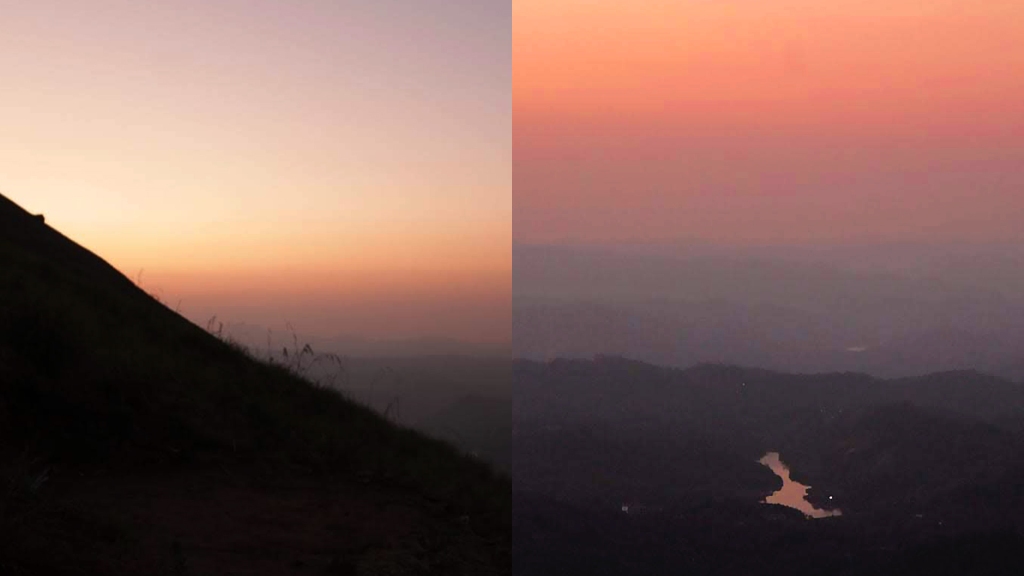
The sun was coming up from the back of the hill and it illuminated the clouds and the scenery down below to new levels of awe! We could now hear shrieking from the tents of people getting up. One after the other people got up and started with the morning greetings. The organisers already began the breakfast prep and called out to us when it was ready. It was Idli and sambar and this time around I loved it. The mama dog and the kid dog were playing with us while we were having breakfast and it was peaceful.
Breakfast was done and we sat around talking about random stuff about life and whatnot. By 9 am, it was time to head back down and say goodbye to the whole camping experience. We were all packed up and looked out to the view one more time, to take it all in and imprint it in the memory.
Climbing down the hill wasn’t easy as it looked either, the steep drops were a pain to the already sore legs but this time around everyone went at the same pace and stuck together. Inch by inch we were coming down from the view and finally after about an hour we reached the main road down below. The guide said he would rent the auto and drop us back to were we were picked up. We fooled around near the road, with the usual jokes and stories of one another. Finally, the auto arrived and dropped us back to where we parked our vehicles. We exchanged goodbyes and numbers to keep in touch. The guide was visibly happy and I assumed that he could go back to his sleep that I interrupted yesterday. He climbs up and down this hill multiple times a week and I guess that can be pretty tiring. One by one everyone hopped on to their vehicles and left. We hopped on to the Royal Enfield to what was a long straight drive back to Trivandrum.
The whole experience was a surreal one, from planing within hours and just going for it amplified the beauty of the experience. The sudden change of environment through travel will definitely change your mood and usher in happiness that you usually long for in a gloomy situation. Keep Travelling! ❤
